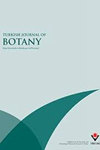
人气:15586
Turkish Journal Of Botany英文简介
The Turkish Journal of Botany is published electronically 6 times a year by the Scientific and Technological Research Council of Turkey (T?B?TAK) and accepts manuscripts (in English) covering all areas of plant biology (including genetics, evolution, systematics, structure, function, development, diversity, conservation biology, biogeography, paleobotany, ontogeny, functional morphology, ecology, reproductive biology, and pollination biology), all levels of organisation (molecular to ecosystem), and all plant groups and allied organisms (algae, fungi, and lichens). Authors are required to frame their research questions and discuss their results in terms of major questions in plant biology. In general, papers that are too narrowly focused, purely descriptive, or broad surveys, or that contain only preliminary data or natural history, will not be considered (*).
The following types of article will be considered:
1. Research articles: Original research in various fields of botany will be evaluated as research articles.
2. Research notes: These include articles such as preliminary notes on a study or manuscripts on the morphological, anatomical, cytological, physiological, biochemical, and other properties of plant, algae, lichen and fungi species.
3. Reviews: Reviews of recent developments, improvements, discoveries, and ideas in various fields of botany.
4. Letters to the editor: These include opinions, comments relating to the publishing policy of the Turkish Journal of Botany, news, and suggestions. Letters should not exceed one journal page.
(*) 1. Raw floristic lists (of algae, lichens, fungi, or plants), species descriptions, chorological studies, and plant sociology studies without any additional independent approaches.
2. Comparative morphology and anatomy studies (that do not cover a family, tribe, subtribe, genus, subgenus, section, subsection, or species complexes with taxonomical problems) without one or more independent additional approaches such as phylogenetical, micromorphological, chromosomal and anatomical analyses.
3. Revisions of family, tribe, genus, subgenus, section, subsection, or species complexes without any original outputs such as taxonomical status changes, IUCN categories, and phenological and ecological analyses.
4. New taxa of all plants without any additional independent approaches such as phylogenetical, ecological, chromosomal, chorological and correlational analyses in addition to a detailed macro- and micro-morphological descriptions with quality field and microscopic illustrations of taxonomically important structures and identification key in the taxonomic group.
New records of all plants without any additional independent approaches such as phylogenetical, ecological, chromosomal, chorological and correlational analyses in addition to a detailed macro- and micro-morphological descriptions with quality field and microscopic illustrations of taxonomically important structures and identification key in the taxonomic group may be accepted for peer review if they contain 3 or more new records or taxonomical status update, such as lectotypification, new combinations, transfers, revivals and synonyms.
5. New taxa of algae, lichens, and fungi without any additional independent approaches such as phylogenetical, ecological, chromosomal, chorological and correlational analyses in addition to a detailed macro- and micro-morphological descriptions with quality field and microscopic illustrations of taxonomically important structures and identification key in the taxonomic group.
New records of algae, lichens, and fungi without any additional independent approaches such as phylogenetical, ecological, chromosomal, chorological and correlational analyses in addition to a detailed macro- and micro-morphological descriptions with quality field and microscopic illustrations of taxonomically important structures and identification key in the taxonomic group may be accepted for peer review if they contain 5 or more new records or taxonomical status update, such as lectotypification, new combinations, transfers, revivals and synonyms.
Turkish Journal Of Botany中文简介
《Turkish Journal Of Botany》是一本由TUBITAK SCIENTIFIC & TECHNICAL RESEARCH COUNCIL TURKEY出版商出版的专业生物期刊,该刊创刊于1994年,刊期Bimonthly,该刊已被国际权威数据库SCIE收录。在中科院最新升级版分区表中,该刊分区信息为大类学科:生物 4区,小类学科:植物科学 4区;在JCR(Journal Citation Reports)分区等级为Q3。该刊发文范围涵盖植物科学等领域,旨在及时、准确、全面地报道国内外植物科学工作者在该领域取得的最新研究成果、工作进展及学术动态、技术革新等,促进学术交流,鼓励学术创新。2021年影响因子为1.429,平均审稿速度较慢,6-12周。
中科院分区最新升级版(当前数据版本:2021年12月最新升级版)
| 大类学科 | 分区 | 小类学科 | 分区 | Top期刊 | 综述期刊 |
| 生物学 | 4区 | PLANT SCIENCES 植物科学 | 4区 | 否 | 否 |
中科院JCR分区历年趋势图
期刊指数
| 影响因子 | h-index | Gold OA文章占比 | 研究类文章占比 | OA开放访问 | 平均审稿速度 |
| 1.429 | 31 | 0.53% | 85.48% | 未开放 | 较慢,6-12周 |
IF值(影响因子)趋势图
热门文章
同领域期刊推荐
- Journal Of Bioinformatics And Compu
- Phytobiomes Journal
- Interdisciplinary Sciences-computat
- Journal Of Biomaterials And Tissue
- Archaea-an International Microbiolo
- Zoology In The Middle East
- Zeitschrift Fur Arznei- & Gewurzpfl
- Seminars In Cell & Developmental Bi
- Russian Journal Of Marine Biology
- Russian Journal Of Developmental Bi
 投稿咨询
投稿咨询